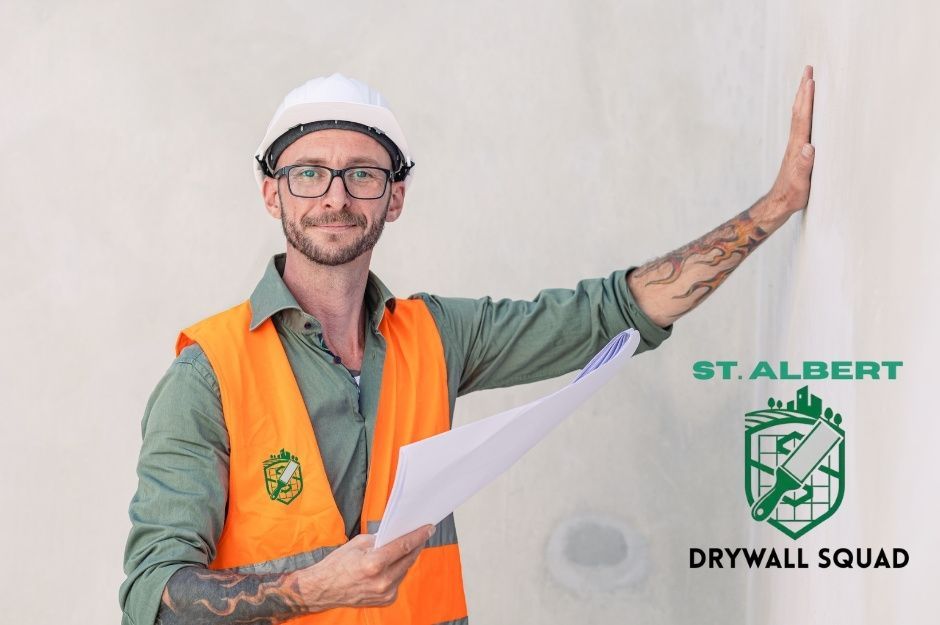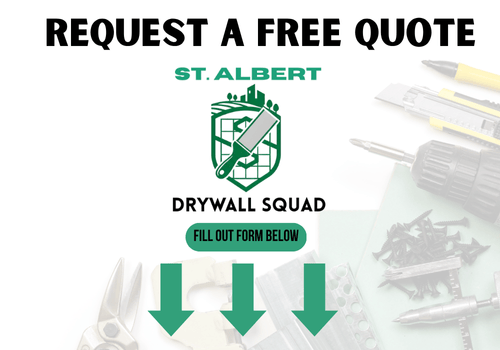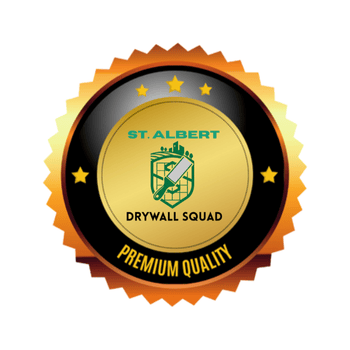Fort Saskatchewan Drywall Repair
Experienced Wallboard Repair Company in Fort Saskatchewan, Alberta

Expert drywall repair contractors at St. Albert Drywall Squad in Fort Saskatchewan provide comprehensive services including crack and hole repairs, water damage restoration, popcorn ceiling removal, and fixing nail pops. These skilled contractors handle everything from hanging new drywall panels to addressing structural issues that cause ongoing problems.

St. Albert Drywall Squad (CP)

Located 25 kilometres northeast of Edmonton with a population of 27,464 (2021 census), Fort Saskatchewan experiences extreme temperature variations—from record lows of -47.5°C to highs of 36.5°C—that cause significant expansion and contraction in building materials, making quality drywall installation and repair essential for local homes.
Professional drywall services extend beyond basic repairs to include complete installation and soundproofing solutions for new construction or renovation projects. They use specialized techniques and materials designed to withstand Fort Saskatchewan's climate conditions.
Quality finishing work through proper mudding and taping ensures your walls look seamless and professional after repairs or installation. The right contractor will match existing textures and prepare surfaces for painting, delivering results that blend invisibly with your existing walls and ceilings.
Expert Drywall Repair Services in Fort Saskatchewan
Professional drywall repair contractors in Fort Saskatchewan specialize in fixing various types of wall damage, from minor cracks and holes to complex water damage restoration. Serving residential neighbourhoods including Downtown, Bridgeview, Clover Park, Pineview, Sherridon, Westpark, and the developing Southfort area, these experts provide precise texture matching and seamless repairs that restore your walls to their original condition.
Addressing Cracks, Holes, and Dents
Crack repair requires identifying the underlying cause before applying the appropriate fix. Settlement cracks need different treatment than stress cracks caused by temperature changes. Fort Saskatchewan's humid continental climate (Köppen: Dfb) with daily mean temperatures ranging from -11.9°C in January to 17.1°C in August creates substantial thermal stress on building materials, making crack prevention and proper repair techniques critical.
Professional drywall repair services assess crack severity and movement patterns. Small hairline cracks receive mesh tape and joint compound application. Larger cracks may require cutting out damaged sections and installing new drywall pieces.
Patching holes involves matching the repair method to hole size. Nail holes get simple spackle application. Larger holes require backing material or drywall patches.
Dent repairs depend on whether the paper surface remains intact. Surface dents need careful sanding and compound application. Deeper dents with torn paper require more extensive patching work.
Quality contractors ensure repairs blend seamlessly with existing wall surfaces through proper preparation and finishing techniques.
Nail and Screw Pop Solutions
Nail and screw pops occur when fasteners work loose from wood movement or improper installation. These create small bumps or cracks in your drywall surface. In Fort Saskatchewan's climate, with average snowfall of 109.7 cm annually and precipitation peaking at 92mm in July, moisture fluctuations combined with temperature extremes frequently cause wood framing to expand and contract, leading to nail pops in both older homes and new construction.
Professional repair involves removing loose fasteners and installing new screws in different locations. Contractors drive screws slightly below the surface without breaking the paper backing.
Wall repair specialists apply three coats of joint compound over popped fasteners:
- First coat: Fills the depression
- Second coat: Feathers edges wider
- Third coat: Creates smooth finish
Proper drying time between coats prevents future cracking. Sand each coat smooth before applying the next layer.
Experienced contractors identify patterns in nail pops that indicate structural issues requiring additional fasteners or different attachment methods.
Popcorn Ceiling and Texture Matching
Popcorn ceilings present unique repair challenges due to their distinctive texture and potential asbestos content in older homes. Professional assessment determines safe removal and repair procedures. Many homes in Fort Saskatchewan's mature neighbourhoods like Bridgeview and Clover Park, which developed during the city's industrial growth period from the 1950s-1980s when the population expanded from 1,076 to over 10,000, may contain popcorn ceilings with asbestos that require certified removal.
Contractors carefully remove damaged popcorn texture sections without disturbing surrounding areas. They apply primer to bare spots before texture application.
Texture matching requires skill and experience with different application techniques:
| Texture Type | Application Method | Drying Time |
|---|---|---|
| Orange Peel | Spray gun | 2-4 hours |
| Knockdown | Trowel finish | 4-6 hours |
| Popcorn | Hopper spray | 6-8 hours |
Water and Moisture Damage Restoration
Moisture damage requires immediate attention to prevent mold growth and structural deterioration. Professional contractors assess damage extent and moisture source elimination. Fort Saskatchewan's location along the North Saskatchewan River, combined with annual precipitation of 454.6mm and peak rainfall months from June through August receiving 80-92mm, creates elevated humidity risks for homes, particularly in basement areas and properties near the river in neighborhoods like Downtown and along the Fort Heritage Precinct.
Water-damaged drywall often needs complete replacement rather than patching. Saturated drywall loses structural integrity and provides ideal conditions for mold development.
Drywall damage from leaks involves cutting out affected areas in regular shapes for easier replacement. Contractors check insulation and framing for moisture damage before installing new drywall.
Proper drying procedures include industrial fans and dehumidifiers. Moisture meters confirm complete drying before sealing repairs.
Professional drywall repair services coordinate with plumbers or roofers to address underlying water sources. They apply mold-resistant primers and paints in previously damaged areas for long-term protection.
Professional Drywall Installation Solutions
Fort Saskatchewan contractors deliver comprehensive drywall installation services for new construction and renovation projects. With the city's 2020 annexation of 952 hectares from Strathcona County and ongoing development in Southfort and Westpark neighbourhoods, demand for new drywall installation in residential construction continues to grow. These specialists handle everything from precise hanging techniques to advanced soundproofing solutions and structural repairs.
Drywall Hanging for Residential and Commercial Projects
Professional contractors measure and cut drywall panels to exact specifications for your project. They secure panels to wall studs and ceiling joists using proper fastening techniques.
Residential Installation Services:
- New home construction drywall hanging
- Room additions and basement finishing
- Garage conversions and attic spaces
Commercial Project Expertise:
- Office building installations
- Retail space buildouts
- Warehouse partition walls
Fort Saskatchewan's Eastgate Business Park and Industrial Business Park, home to major employers including Dow Chemical, Sherritt International, Nutrien, Linde (Praxair), and Shell Canada, require specialized commercial drywall installation that meets industrial building codes and fire resistance standards for chemical processing facilities.
Contractors use specialized tools to ensure panels align perfectly with existing structures. They handle different drywall thicknesses based on your building requirements.
Standard residential installations typically use ½-inch panels. Commercial projects may require ⅝-inch drywall for enhanced fire resistance.
Professional installation prevents future cracking and ensures smooth wall surfaces. Contractors check for proper stud spacing before hanging any panels.
Soundproofing Expertise
Soundproof drywall installation requires specialized materials and techniques beyond standard hanging methods. Contractors install acoustic drywall panels with sound-dampening properties.
Soundproofing Solutions:
- Double-layer drywall installation
- Sound-dampening insulation placement
- Resilient channel systems
- Acoustic sealant application
Professional installers create air gaps between wall layers to reduce sound transmission. They use thicker panels or multiple drywall layers for maximum noise reduction.
Home theaters and recording studios benefit from specialized soundproof installation. Contractors seal all gaps and joints with acoustic caulking materials.
Multi-family housing projects often require soundproof drywall between units. Professional installation ensures compliance with local building noise regulations. As Fort Saskatchewan continues developing multi-family residential units in growing neighbourhoods like Westpark and Southfort, soundproofing between units has become increasingly important for maintaining quality of life in higher-density housing.
Handling Sagging and Seam Issues
Drywall damage from sagging panels requires immediate professional attention to prevent further structural problems. Contractors identify underlying causes like inadequate support or moisture issues.
Common Sagging Causes:
- Insufficient ceiling joist spacing
- Heavy insulation loads
- Water damage from leaks
- Age-related material fatigue
In Fort Saskatchewan's older residential areas built during the 1950s-1970s industrial boom, homes may have ceiling joists spaced further apart than modern building codes require, making sagging drywall a common issue in properties from the Sherridon, Pineview, and original Clover Park developments.
Professional repair involves removing damaged sections and installing additional support framing. Contractors add blocking or furring strips to strengthen ceiling attachments.
Seam problems develop when joints separate or crack along panel edges. Proper installation prevents these issues through correct spacing and fastening techniques.
Contractors use appropriate joint compound and tape systems during initial installation. They ensure panels meet at stud centers for maximum joint strength.
Quality Drywall Finishing and Mudding & Taping
Professional drywall finishing transforms rough installations into smooth, paint-ready surfaces through expert mudding techniques and precision taping. These critical steps ensure your walls achieve a flawless appearance that enhances any interior space.
Comprehensive Mudding Services
Mudding involves applying joint compound to create uniform wall surfaces. Fort Saskatchewan contractors use specialized compounds designed for Alberta's climate conditions.
The process begins with first coat application over taped seams. Contractors spread compound evenly using 6-inch knives for initial coverage.
Second coat mudding expands coverage with 10-inch knives. This step feathers edges and builds proper thickness over joints and fastener holes.
The final coat uses 12-inch knives for seamless blending. Expert contractors apply thin layers that eliminate visible transitions between compound and drywall.
Different compound types serve specific purposes:
- Setting compounds for initial coats
- Topping compounds for final smoothing
- Lightweight compounds for easier sanding
Proper drying time between coats prevents cracking and ensures durability. Fort Saskatchewan's average of 102.6 precipitation days annually means contractors must carefully time interior finishing work and allow adequate drying periods between coats, particularly during humid summer months when precipitation peaks. Professional mudding creates the foundation for quality painting results.
Precision Taping for Seamless Joints
Taping reinforces drywall seams to prevent cracking and create invisible joints. Contractors select appropriate tape materials based on joint types and project requirements.
Paper tape provides maximum strength for flat seams. It bonds chemically with joint compound and resists bubbling when properly embedded.
Mesh tape works well for repairs and inside corners. Its adhesive backing simplifies application but requires more compound coverage.
The taping process follows precise steps:
- Apply compound bed along seams
- Position tape carefully without gaps
- Embed tape with proper pressure
- Remove excess compound immediately
Corner beads protect outside edges and create sharp lines. Metal and plastic options suit different applications and durability needs.
Professional tapers ensure consistent pressure and alignment. Their experience prevents common issues like air bubbles, wrinkles, or loose edges that compromise finish quality.
Surface Priming and Painting Preparation
Proper surface preparation ensures painting success and longevity. Contractors sand finished surfaces to eliminate imperfections and create uniform texture.
Progressive sanding starts with 120-grit paper for initial smoothing. Fine 220-grit paper provides final surface refinement without scratching.
Dust removal is critical before painting. Contractors use tack cloths and vacuum systems to eliminate all particles that could affect paint adhesion.
Primer selection depends on your chosen paint type:
- PVA primers for new drywall
- High-build primers for texture matching
- Stain-blocking primers for repairs
Professional contractors inspect surfaces under angled lighting. This reveals minor imperfections that require additional attention before painting begins.
Proper preparation prevents paint failures like peeling, uneven coverage, or visible joint lines. Your investment in quality finishing pays dividends in long-term appearance and durability.
The Drywall Repair and Finishing Process
Professional drywall repair follows a systematic approach that ensures quality results through proper assessment, careful preparation, precise execution, and thorough inspection. Each phase builds upon the previous one to deliver seamless wall surfaces ready for painting or other finishes.
Initial Assessment and Customized Solutions
Your contractor begins with a thorough evaluation of all damaged areas. They examine cracks, holes, dents, nail pops, and water damage to determine the underlying causes and appropriate repair methods.
Common assessment findings include:
- Small holes requiring mesh patches
- Large holes needing backing material
- Moisture damage requiring source identification
- Structural issues affecting drywall integrity
The assessment identifies whether damage stems from settling, moisture problems, or impact. Your contractor develops a repair plan that addresses both visible damage and root causes to prevent future issues. Fort Saskatchewan properties built on varying soil conditions near the North Saskatchewan River may experience differential settling, requiring contractors to assess foundation movement patterns before recommending permanent drywall repair solutions.
Different damage types require specific approaches. Small nail holes need simple filling, while larger holes require cutting and patching techniques.
Preparation and Protection of Work Areas
Contractors protect your furniture and flooring with plastic sheeting and drop cloths. They remove loose drywall material and clean damaged areas to ensure proper adhesion of repair materials.
Essential preparation steps include:
- Surface cleaning to remove dust and debris
- Damage expansion to reach sound material
- Tool preparation including joint compound and tape
- Workspace setup for efficient material access
Your repair team cuts away damaged sections with clean, straight edges. They sand rough areas and prime any exposed paper backing to prevent moisture absorption during repair.
Proper preparation prevents contamination that could compromise repair quality. Clean surfaces ensure joint compound bonds effectively with existing drywall.
Repair Execution and Attention to Detail
Contractors apply repairs using industry-standard techniques. They install backing material for larger holes, apply mesh or paper tape for cracks, and use multiple coats of joint compound for smooth finishes.
The repair process involves:
- First coat - embedding tape and covering repairs
- Second coat - feathering edges wider than the first
- Third coat - final smoothing and blending
- Sanding - creating uniform surface texture
Each coat must dry completely before the next application. Your contractor sands between coats to eliminate imperfections and achieve seamless blending with surrounding surfaces.
Texture matching requires skill and experience. Contractors recreate existing wall patterns to make repairs invisible after painting.
Final Inspection and Satisfaction Guarantee
Your contractor conducts a comprehensive inspection using proper lighting to identify any imperfections. They check for smoothness, proper texture matching, and seamless integration with existing surfaces.
Quality checkpoints include:
- Surface uniformity across all repaired areas
- Texture consistency matching original patterns
- Edge blending with no visible repair lines
- Painting readiness with proper primer application
Any identified issues receive immediate correction. Your contractor ensures surfaces are ready for painting by applying appropriate primer to new joint compound areas.
The final walkthrough confirms all repairs meet professional standards. You receive guidance on paint selection and application timing for optimal results.